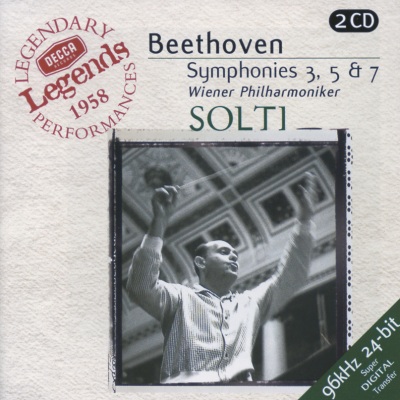
Beethoven: Symphonies Nos. 3,5 & 7
Dating from the late 1950s, these generally fine performances show Solti’s consistency as a Beethoven interpreter. In fact, timings are virtually identical to his later versions (give or take a repeat or two). Even at this comparatively early date a craggy directness entirely appropriate to Beethoven characterized the conductor’s approach–and how many contemporaries at the time took the exposition repeat in the Eroica’s first movement? Solti’s Beethoven always has been underrated. In some respects it’s more satisfying than his ventures into the late Romantic repertoire on which his reputation largely rests. His Fifth Symphony, for example, has all of the drama and flair you could ask for in its outer movements, and his treatment of the Third’s epic funeral march is truly gripping, with a hair-raising fugato climax. The Seventh also seethes with energy (terrific finale!), and it’s only in the slow movements of both this work and the Fifth where the grip slackens a bit. The grainy quality of the Vienna Philharmonic strings and the very close recording balances (particularly regarding cellos and basses) also contribute to this impression. At this date, the orchestra still lacked its famously alluring tonal qualities, an observation additionally confirmed by some sour wind playing in quieter passages. There are also one or two odd directives from the podium, such as the fussy treatment of the Eroica finale’s coda. Still, anyone encountering these performances for the first time will be pleasantly surprised at how exciting, musical, and competitive they remain more than 40 years on. It’s certainly clear what all the excitement was about, and if Solti’s subsequent career only partially fulfilled the promise on display here, he’s in good company. I’ll take his Beethoven over Karajan’s any day. David Hurwitz, classicstoday.com [3/21/2001]
